travel 教案
- 格式:pdf
- 大小:226.74 KB
- 文档页数:10
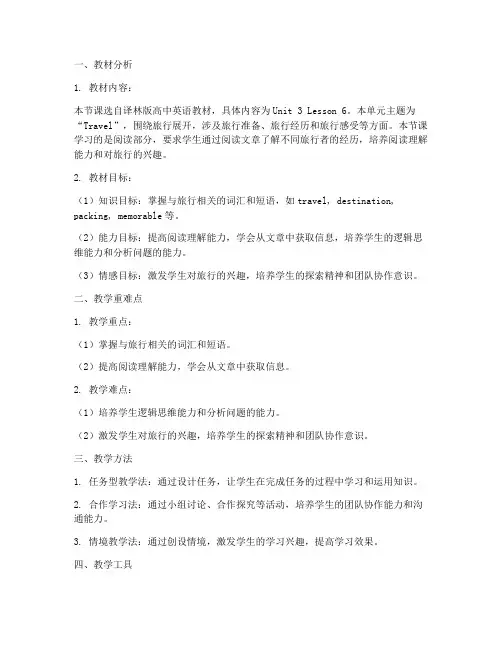
一、教材分析1. 教材内容:本节课选自译林版高中英语教材,具体内容为Unit 3 Lesson 6。
本单元主题为“Travel”,围绕旅行展开,涉及旅行准备、旅行经历和旅行感受等方面。
本节课学习的是阅读部分,要求学生通过阅读文章了解不同旅行者的经历,培养阅读理解能力和对旅行的兴趣。
2. 教材目标:(1)知识目标:掌握与旅行相关的词汇和短语,如travel, destination, packing, memorable等。
(2)能力目标:提高阅读理解能力,学会从文章中获取信息,培养学生的逻辑思维能力和分析问题的能力。
(3)情感目标:激发学生对旅行的兴趣,培养学生的探索精神和团队协作意识。
二、教学重难点1. 教学重点:(1)掌握与旅行相关的词汇和短语。
(2)提高阅读理解能力,学会从文章中获取信息。
2. 教学难点:(1)培养学生逻辑思维能力和分析问题的能力。
(2)激发学生对旅行的兴趣,培养学生的探索精神和团队协作意识。
三、教学方法1. 任务型教学法:通过设计任务,让学生在完成任务的过程中学习和运用知识。
2. 合作学习法:通过小组讨论、合作探究等活动,培养学生的团队协作能力和沟通能力。
3. 情境教学法:通过创设情境,激发学生的学习兴趣,提高学习效果。
四、教学工具1. 多媒体课件:用于展示教学内容,提高教学效果。
2. 课堂练习册:用于巩固所学知识,检验学习效果。
3. 白板、粉笔等:用于板书和演示。
五、教学过程1. 导入(1)播放一段关于旅行的视频,激发学生的兴趣。
(2)提问:同学们,你们都去过哪些地方旅行?旅行中有什么难忘的经历?2. 阅读教学(1)让学生阅读课文,了解文章大意。
(2)引导学生分析文章结构,总结文章主题。
(3)讲解重点词汇和短语,帮助学生理解文章内容。
3. 小组讨论(1)将学生分成小组,讨论以下问题:a. 文章中提到了哪些旅行目的地?b. 旅行者在旅行中遇到了哪些困难?c. 旅行给你的生活带来了哪些改变?(2)每组选派代表分享讨论成果。
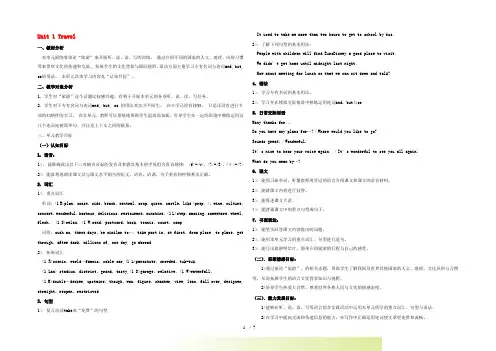
Unit 1 Travel一、教材分析本单元围绕着谈论“旅游”来开展听、说、读、写的训练。
通过介绍不同的国家的人文、地理、风俗习惯等来贯穿文化的传递和交流,拓展学生的文化背景与国际视野。
语法方面主要学习专有名词与连词and, but, so的用法。
本单元具体学习内容见“认知目标”。
二、教学对象分析1. 学生对“旅游”这个话题比较感兴趣,有利于开展本单元的各项听、说、读、写任务。
2. 学生对于专有名词与连词and, but, so 的用法其实并不陌生,在小学已经有接触,只是还没有进行专项的归纳性的学习。
在本单元,教师可以系统地帮助学生温故而知新,引导学生在一定的语境中熟练运用这几个连词连接简单句,并注意上下文之间的联系。
三、单元教学目标(一)认知目标1. 语音:1). 能准确读出以下三对辅音音标的发音及掌握其基本的字母组合发音规律: /f/-/v/,/?/-/3/,/θ/-/?/ 2).能流利地朗读课文及与课文水平相当的短文,语音、语调、句子重音和停顿基本正确。
2. 词汇1).重点词汇单词:(1 R)plan,coast,side,beach,central,crop,queen,castle,like (prep.),wine,culture,concert,wonderful,harbour, delicious,restaurant,sunshine,(1 L)step,amazing,somewhere,wheel,flesh, (1 S)relax,(1 W)send,postcard,back,tennis,court,camp词组:such as,these days,be si milar to…,take part in,at first,from place to place,get through,after dark,millions of, one day, go abroad2).拓展词汇(1 R)scenic,world—famous,cable car,(1 L)parachute,crowded,tuk-tuk,(1 Lan) stadium,district,grand,tasty,(1 S)garage,relative,(1 W)waterfall,(1 M)double—decker, upstairs,though,wax,figure,chamber, view, lean,fall over, designer, straight,reopen,restricted3. 句型1).复习动词take表“花费”的句型 It used to take me more than two hours to get to school by bus.2).了解下列句型的基本用法:People with children will find EuroDisney a good place to visit.We didn’t get home until midnight last night.How about meeting for lunch so that we can sit down and talk?4. 语法1).学习专有名词的基本用法。
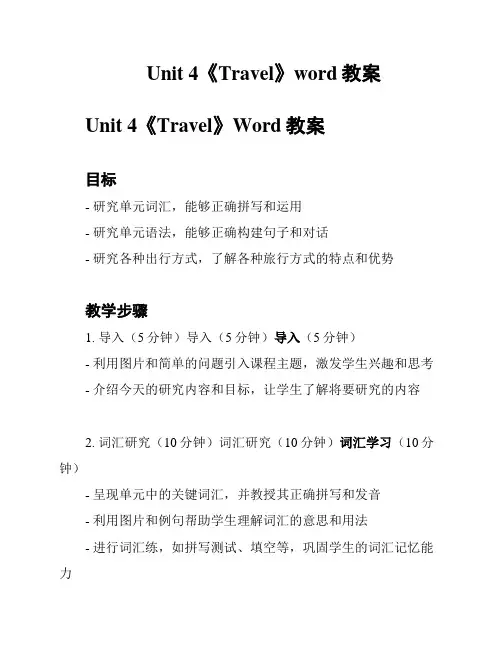
Unit 4《Travel》word教案Unit 4《Travel》Word教案目标- 研究单元词汇,能够正确拼写和运用- 研究单元语法,能够正确构建句子和对话- 研究各种出行方式,了解各种旅行方式的特点和优势教学步骤1. 导入(5分钟)导入(5分钟)导入(5分钟)- 利用图片和简单的问题引入课程主题,激发学生兴趣和思考- 介绍今天的研究内容和目标,让学生了解将要研究的内容2. 词汇研究(10分钟)词汇研究(10分钟)词汇学习(10分钟)- 呈现单元中的关键词汇,并教授其正确拼写和发音- 利用图片和例句帮助学生理解词汇的意思和用法- 进行词汇练,如拼写测试、填空等,巩固学生的词汇记忆能力3. 语法研究(15分钟)语法研究(15分钟)语法学习(15分钟)- 介绍本单元的语法知识,如行为动词的使用、there be句型等- 通过示例句和练让学生掌握语法结构的运用和句子的构建- 引导学生进行语法练,如句型转换、造句等,提高语法应用能力4. 听力训练(15分钟)听力训练(15分钟)听力训练(15分钟)- 播放与本单元内容相关的听力材料- 要求学生仔细听,并针对听力内容进行问题回答,培养学生的听力理解能力- 分析听力材料中的重点词汇、常用表达和语言模式,帮助学生更好地理解听力内容5. 口语表达(15分钟)口语表达(15分钟)口语表达(15分钟)- 设置角色扮演和对话练活动,让学生运用所学内容进行口语表达- 设计问题和情景,引导学生进行对话练,培养学生的口语流利度和表达能力- 鼓励学生互相交流和合作,提供积极反馈和指导6. 任务和练(15分钟)任务和练(15分钟)任务和练习(15分钟)- 分配任务,要求学生完成与本单元相关的小组活动或练题- 监督学生的任务进展,解答学生的问题,帮助他们解决困惑- 收集学生的作业,给予评价和改进建议7. 总结和反馈(5分钟)总结和反馈(5分钟)总结和反馈(5分钟)- 总结本节课的研究内容和要点,强调学生的研究成果和进步- 给予学生针对本节课表现的反馈和建议- 为下节课预告内容,激发学生对研究的兴趣总结本节课旨在通过词汇学习、语法学习、听力训练、口语表达和任务练习,帮助学生掌握与旅行相关的词汇和语法知识,并提高他们的听说能力。
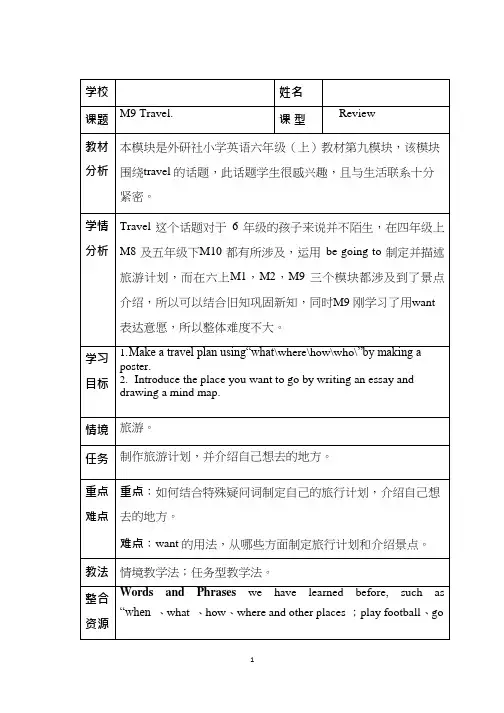
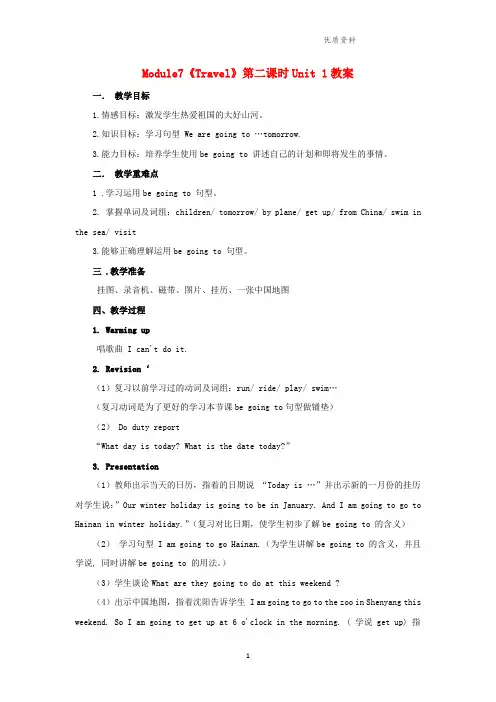
Module7《Travel》第二课时Unit 1教案一.教学目标1.情感目标:激发学生热爱祖国的大好山河。
2.知识目标:学习句型 We are going to …tomorrow.3.能力目标:培养学生使用be going to 讲述自己的计划和即将发生的事情。
二.教学重难点1 .学习运用be going to 句型。
2. 掌握单词及词组:children/ tomorrow/ by plane/ get up/ from China/ swim in the sea/ visit3.能够正确理解运用be going to 句型。
三 .教学准备挂图、录音机、磁带、图片、挂历、一张中国地图四、教学过程1. Warming up唱歌曲 I can't do it.2. Revision‘(1)复习以前学习过的动词及词组:run/ ride/ play/ swim…(复习动词是为了更好的学习本节课be going to句型做铺垫)(2) Do duty report“What day is today? What is the date tod ay?”3. Presentation(1)教师出示当天的日历,指着的日期说“Today is …”并出示新的一月份的挂历对学生说:”Our winter holiday is going to be in January. And I am going to go to Hainan in winter holiday.”(复习对比日期,使学生初步了解be going to 的含义)(2)学习句型 I am going to go Hainan.(为学生讲解be going to 的含义,并且学说, 同时讲解be going to 的用法。
)(3)学生谈论What are they going to do at this weekend ?(4)出示中国地图,指着沈阳告诉学生 I am going to go to the zoo in Shenyang this weekend. So I am going to get up at 6 o'clock in the morning. ( 学说 get up) 指着海南说And I am going to go to Hainan. I am going to swim in the sea.( 出示图片,边做动作边学说swim in the sea)(5)教师出示一张老爷爷的照片,告诉学生I am going to visit my grandpa, too.( 学说 visit my grandpa)4. Practice猜一猜:What is he\ she going to do tomorrow?第一组:学生根据图片来猜:可以出示“天安门、石林、泰山、世博园、东方明珠”等风景名胜,学生可以说出“ He is going to go to Beijing.”等句子。
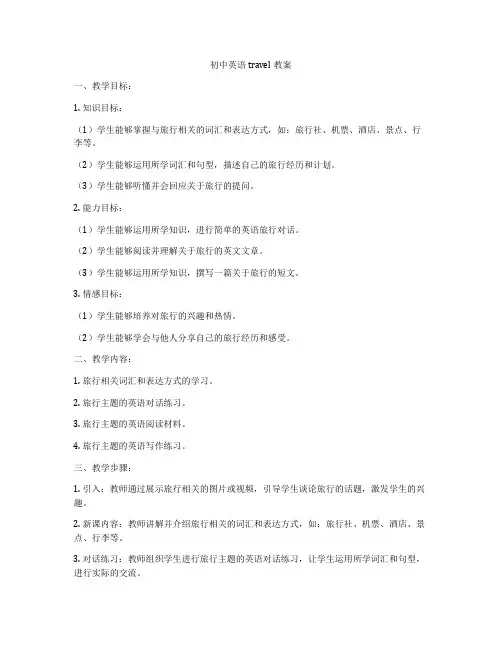
初中英语travel教案一、教学目标:1. 知识目标:(1)学生能够掌握与旅行相关的词汇和表达方式,如:旅行社、机票、酒店、景点、行李等。
(2)学生能够运用所学词汇和句型,描述自己的旅行经历和计划。
(3)学生能够听懂并会回应关于旅行的提问。
2. 能力目标:(1)学生能够运用所学知识,进行简单的英语旅行对话。
(2)学生能够阅读并理解关于旅行的英文文章。
(3)学生能够运用所学知识,撰写一篇关于旅行的短文。
3. 情感目标:(1)学生能够培养对旅行的兴趣和热情。
(2)学生能够学会与他人分享自己的旅行经历和感受。
二、教学内容:1. 旅行相关词汇和表达方式的学习。
2. 旅行主题的英语对话练习。
3. 旅行主题的英语阅读材料。
4. 旅行主题的英语写作练习。
三、教学步骤:1. 引入:教师通过展示旅行相关的图片或视频,引导学生谈论旅行的话题,激发学生的兴趣。
2. 新课内容:教师讲解并介绍旅行相关的词汇和表达方式,如:旅行社、机票、酒店、景点、行李等。
3. 对话练习:教师组织学生进行旅行主题的英语对话练习,让学生运用所学词汇和句型,进行实际的交流。
4. 阅读材料:教师提供关于旅行的英文阅读材料,学生阅读并理解文章内容。
5. 写作练习:教师布置关于旅行的英语写作作业,要求学生运用所学知识,撰写一篇关于旅行的短文。
6. 总结与反馈:教师对学生的学习情况进行总结和反馈,鼓励学生分享自己的旅行经历和感受。
四、教学评价:1. 课堂参与度:观察学生在课堂上的积极参与程度,以及与旅行主题相关的表达和交流。
2. 阅读理解:评估学生在阅读关于旅行的英文文章时的理解能力。
3. 写作能力:评估学生在撰写关于旅行的短文时的语言表达能力和创造力。
4. 对话练习:评估学生在旅行主题的英语对话练习中的语言运用能力。
五、教学资源:1. 旅行相关的图片或视频。
2. 旅行主题的英语对话材料。
3. 旅行主题的英语阅读文章。
4. 旅行主题的英语写作模板或指导材料。
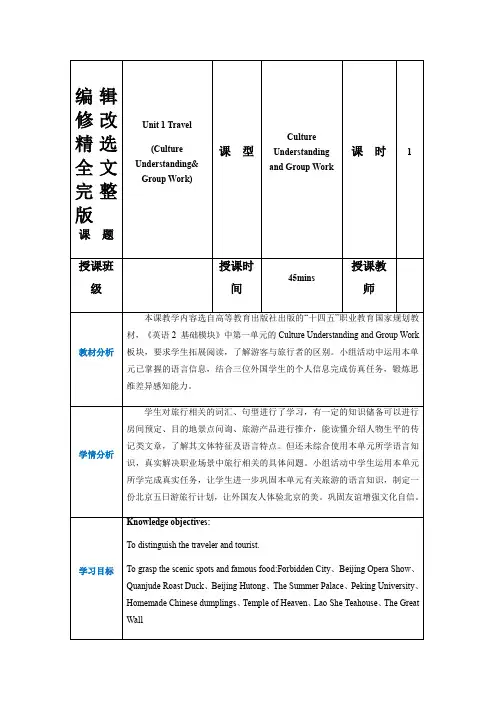
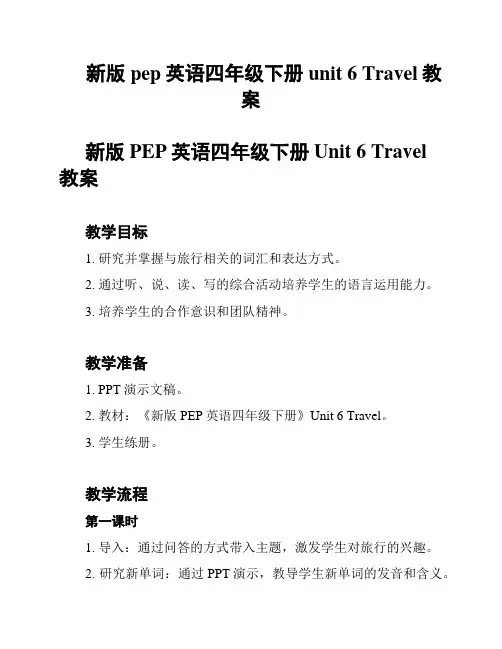
新版pep英语四年级下册unit 6 Travel教案新版PEP英语四年级下册Unit 6 Travel教案教学目标1. 研究并掌握与旅行相关的词汇和表达方式。
2. 通过听、说、读、写的综合活动培养学生的语言运用能力。
3. 培养学生的合作意识和团队精神。
教学准备1. PPT演示文稿。
2. 教材:《新版PEP英语四年级下册》Unit 6 Travel。
3. 学生练册。
教学流程第一课时1. 导入:通过问答的方式带入主题,激发学生对旅行的兴趣。
2. 研究新单词:通过PPT演示,教导学生新单词的发音和含义。
3. 听录音并完成相应的练:学生跟随录音,完成听力练。
4. 朗读和说一说:学生以小组为单位,依次朗读和说一说对话内容。
5. 巩固练:学生翻开练册,完成相关的练题。
6. 小结:总结本节课所学的内容,激励学生的研究兴趣。
第二课时1. 导入:复上节课所学的单词和句子。
2. 研究新知识:通过PPT演示,教导学生新知识点的发音和用法。
3. 听录音并完成相应的练:学生跟随录音,完成听力练。
4. 朗读和说一说:学生以小组为单位,依次朗读和说一说对话内容。
5. 合作练:学生分组进行角色扮演,通过实际场景练对话和交流。
6. 小结:总结本节课所学的内容,激励学生的研究兴趣。
教学评价1. 通过观察学生的参与度和表现,以及完成练的情况,进行教学评价。
2. 鼓励学生积极参与课堂活动,提高语言运用能力。
注意事项1. 确保教学流程清晰明确,让学生能够理解和跟随。
2. 鼓励学生积极思考和提问,促进学生的研究动力和思维能力。
3. 在教学中适当引入多媒体和实物等辅助教具,使学习更加生动有趣。
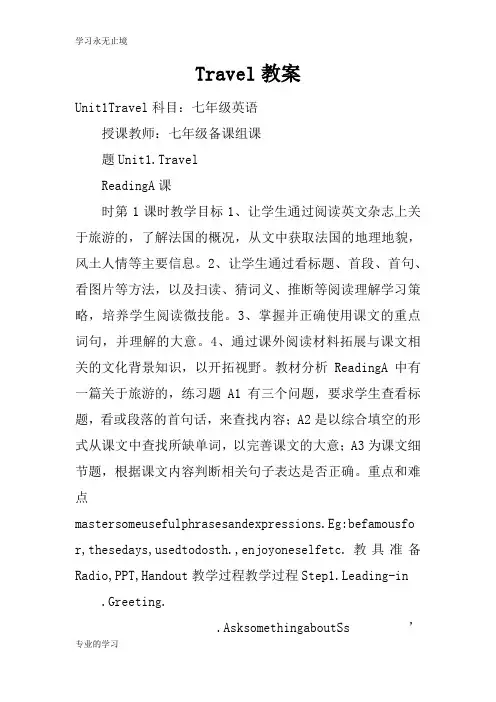
Travel教案Unit1Travel科目:七年级英语授课教师:七年级备课组课题Unit1.TravelReadingA课时第1课时教学目标1、让学生通过阅读英文杂志上关于旅游的,了解法国的概况,从文中获取法国的地理地貌,风土人情等主要信息。
2、让学生通过看标题、首段、首句、看图片等方法,以及扫读、猜词义、推断等阅读理解学习策略,培养学生阅读微技能。
3、掌握并正确使用课文的重点词句,并理解的大意。
4、通过课外阅读材料拓展与课文相关的文化背景知识,以开拓视野。
教材分析ReadingA中有一篇关于旅游的,练习题A1有三个问题,要求学生查看标题,看或段落的首句话,来查找内容;A2是以综合填空的形式从课文中查找所缺单词,以完善课文的大意;A3为课文细节题,根据课文内容判断相关句子表达是否正确。
重点和难点mastersomeusefulphrasesandexpressions.Eg:befamousfo r,thesedays,usedtodosth.,enjoyoneselfetc.教具准备Radio,PPT,Handout教学过程教学过程Step1.Leading-in .Greeting..AsksomethingaboutSs’winterholidayorally.Eg.whatdidyoudoinyourwinterholi day?DidyouvisityourrelativesinSpringFestival?Ifyouh avetimeormoney,wherewillyouspendyourSpringFestival? Step2.Pre-reading.ShowapictureoftheEiffelTowerinFrance.Thenshowt hehumourcartoonbetweenHiandLo.AsktheSspayattentiont oadoublemeaning..Showsomenationalflagofdifferentcountries,askSs matchthemcorrectly..TelltheSsthattheyaregoingtolearnapassageaboutF rance.AsksomeSstosaysomethingaboutFrance..ShowamapofwestEuropetotheSs,trytofindFranceand somefamouscitiesinFrance,suchasParisetc..Teachthenewwordsinthistextbyshowingsomepicture .Suchas:coast,scenic,beachetc.Step3.while-reading .AsktheSstoskimthepassageandanswerthequestion..Readthepassageagainandfillinatable..ReadfordetailsandfinishthereadingtaskinEnglish weeklyReadingA.Step4.Post-reading.Readthepassagealoud,payattentiontothenewwordsa ndthepropernouns..Trytofindoutsomeusefulphrasesandexpressionsinthistext..FinishtherelevantexercisesinEnglishweekly..Finishtheexercisesinthehandout.Step5.Homework.FinishtheexercisesinEnglishweekly..TrytowriteashortpassageaboutFrance.Atleast8sen tences.教学反思7B教案设计科目:七年级英语授课教师:七年级备课组课题Unit1.TravelReadingB课时第2课时教学目标1、让学生阅读一篇介绍旧金山的,了解描述旅游地应包含的基本信息。
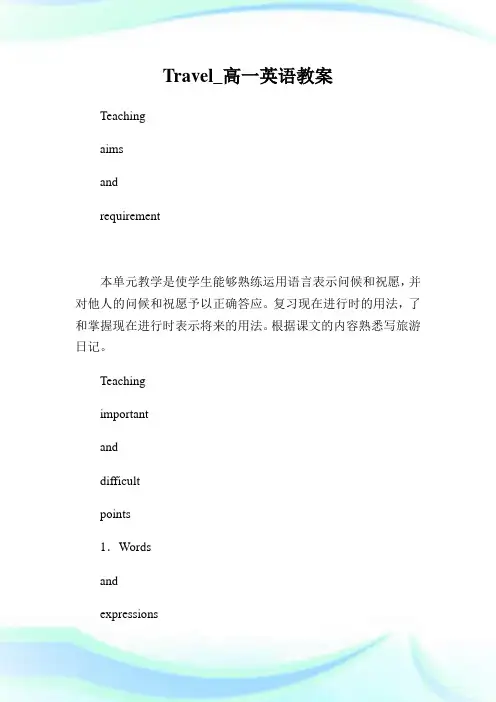
Travel_高一英语教案Teachingaimsandrequirement本单元教学是使学生能够熟练运用语言表示问候和祝愿,并对他人的问候和祝愿予以正确答应。
复习现在进行时的用法,了和掌握现在进行时表示将来的用法。
根据课文的内容熟悉写旅游日记。
Teachingimportantanddifficultpoints1.Wordsandexpressionsseparate, guide, sharp, destroy, through, across, travel, trip, journey, gooff see...offtaketaxi/train/bus...,bytaxi/train/bus...,tie...to,moveon,bemadefrom/of/into/by/,in..everytwoorthree days 2.Useful phasesbeabouttodo; nothing except/but. .3.Oral expressionsGivemyregardsto...Haveanice/good/wonderfultime!Haveagood/pleasant trip!Say“Hi/Hello”tosb.fromme.Goodluck!Thesametoyou! 4.GrammarRevisethe Present Continuous Tenseisoftenusedforplansthenear future.教学建议一、能力训练1.设置若干情境,用现在进行时自编对话,安排未来的学习和生活,并对对方的计划提出良好祝愿。
2.讨论森林遭到破坏的原因。
3.学会制订旅行计划,思考如何解决野外旅行时遇到的意外及如何写好旅行日记。
二、德育渗透1.旅行的意义:开阔视野,丰富知识,陶冶情操等。
2.我国是个森林覆盖率极低的国家,如何保护森林、合理利用现有耕地是个有待解决的问题。
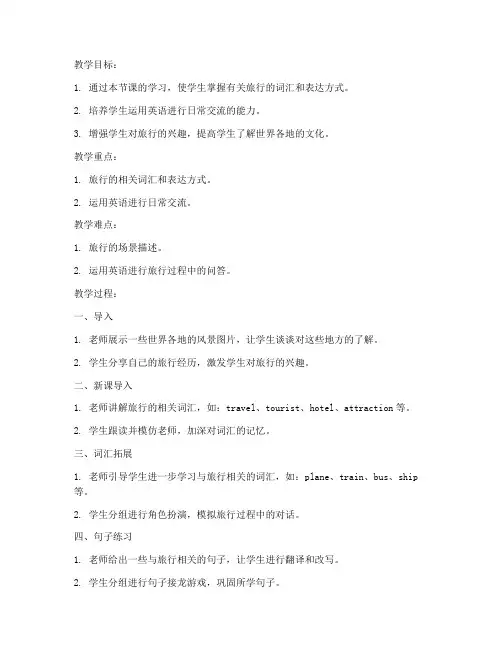
教学目标:1. 通过本节课的学习,使学生掌握有关旅行的词汇和表达方式。
2. 培养学生运用英语进行日常交流的能力。
3. 增强学生对旅行的兴趣,提高学生了解世界各地的文化。
教学重点:1. 旅行的相关词汇和表达方式。
2. 运用英语进行日常交流。
教学难点:1. 旅行的场景描述。
2. 运用英语进行旅行过程中的问答。
教学过程:一、导入1. 老师展示一些世界各地的风景图片,让学生谈谈对这些地方的了解。
2. 学生分享自己的旅行经历,激发学生对旅行的兴趣。
二、新课导入1. 老师讲解旅行的相关词汇,如:travel、tourist、hotel、attraction等。
2. 学生跟读并模仿老师,加深对词汇的记忆。
三、词汇拓展1. 老师引导学生进一步学习与旅行相关的词汇,如:plane、train、bus、ship 等。
2. 学生分组进行角色扮演,模拟旅行过程中的对话。
四、句子练习1. 老师给出一些与旅行相关的句子,让学生进行翻译和改写。
2. 学生分组进行句子接龙游戏,巩固所学句子。
五、情景模拟1. 老师设计一个旅行场景,如:在机场、酒店、景点等。
2. 学生分组进行角色扮演,运用所学词汇和表达方式进行对话。
六、总结与反思1. 老师引导学生回顾本节课所学内容,总结旅行相关词汇和表达方式。
2. 学生分享自己在角色扮演中的收获,提出自己在学习过程中遇到的问题。
七、布置作业1. 学生完成课后练习题,巩固所学词汇和表达方式。
2. 学生收集有关世界各地的风景图片,准备在下次课上分享。
教学反思:本节课通过词汇讲解、角色扮演、情景模拟等多种教学手段,使学生掌握了有关旅行的词汇和表达方式,提高了学生运用英语进行日常交流的能力。
在教学过程中,要注意以下几点:1. 注重词汇的讲解,让学生掌握旅行的基本词汇。
2. 鼓励学生积极参与课堂活动,提高他们的学习兴趣。
3. 注重情景模拟,让学生在实际运用中提高英语水平。
4. 关注学生的个体差异,因材施教,使每个学生都能在课堂上有所收获。
四年级下册英语教案Unit 6 Travel(4个课时)|鲁科版(五四制)教学内容本单元主要围绕“Travel”这一主题展开,通过四个课时的学习,学生将掌握与旅行相关的词汇、句型和表达方式。
教学内容包括:1. 词汇:plane, train, ship, bus, car, subway, ticket, passport, suitcase等;2. 句型: How do you go to? I go to; Where do you wantto travel? I want to travel to; Can I see your passport and ticket, please? Sure, here you are.等;3. 表达方式:询问和回答关于旅行方式、目的地、行李等问题。
教学目标1. 能够正确运用与旅行相关的词汇和句型进行口语交流;2. 能够听懂并参与关于旅行的对话;3. 能够阅读并理解与旅行相关的短文;4. 能够运用所学知识,编写简单的旅行对话或短文;5. 培养学生对旅行的兴趣和好奇心,提高跨文化交际能力。
教学难点1. 词汇的发音和记忆;2. 句型的正确运用和灵活替换;3. 听力理解和口语表达能力;4. 旅行相关文化的了解和尊重。
教具学具准备1. 教师准备:多媒体课件、教学图片、单词卡片、练习册等;2. 学生准备:课本、练习本、彩色笔等。
教学过程第一课时1. 导入:通过图片或视频展示不同的旅行场景,引导学生谈论旅行经历;2. 新课内容:学习本课的词汇和句型,进行角色扮演和小组活动;3. 练习:完成练习册上的相关练习,巩固所学知识;4. 作业:复习本课所学内容,预习下一课时。
第二课时1. 复习:回顾上一课时的词汇和句型,进行口语练习;2. 新课内容:学习本课的词汇和句型,进行听力训练和阅读理解;3. 活动:设计旅行计划,模拟旅行场景,进行角色扮演;4. 作业:复习本课所学内容,预习下一课时。
游学教案:Travel:Travel1.游学目的游学,即学生通过旅行的方式去了解不同的国家,文化和生活方式。
游学的目的在于提高学生的个人修养,丰富学生的阅历和知识储备,让学生更快速的逐渐成长,同时为他们未来的职业规划打下更坚实的基础。
2.游学日期时间定在暑假或寒假期间。
3.游学目标(1) 给学生提供一次自主出国的机会,增加他们的国际化视野。
(2) 帮助学生掌握外语技能,提高他们的语言沟通能力。
(3) 增加学生的人际交往能力。
(4) 让学生从不同国家、不同文化和不同生活方式中获取经验,优化他们的思维方式。
(5) 增加学生对未来职业生涯规划的认识,锻炼他们的职业素养。
4.游学安排(1) 行程安排:行程安排包括旅行路线、所参观景点的简介、介绍当地文化和历史背景等内容,可以和当地旅游机构合作。
(2) 外语学习:游学过程中,每天会有英语或当地语言的课程安排,掌握语言交流技巧。
(3) 人际交往:每位学生参加游学的国家会有当地学生陪伴,交流学习经验,加强交流与沟通。
(4) 职业规划:与当地企业合作,利用参观的机会给学生提供实习或参观机会,了解企业经营和管理方式,增加对职业生涯的认知。
5.游学收获(1) 增强国际视野和语言交流能力。
(2) 提升个人修养与文化素养。
(3) 拓展思维方式和生活方式。
(4) 收获人际交往和社交技巧。
(5) 更有效地为自己未来的职业发展打下坚实的基础。
6.游学注意事项(1) 选择游学机构时要慎重,选择口碑较好的机构,保证安全。
(2) 合理安排时间,充分利用每一天,不要浪费时间。
(3) 做好文化适应方面的准备,尊重当地文化习俗。
(4) 随身携带重要证件,包括护照、身份证等。
(5) 不要过度依赖当地的游学机构,时刻保持警惕。
游学教案:Travel旨在为学生提供更广阔的成长空间,让他们从中获取实在且有意义的学习经验,帮助他们探索更广阔的世界、提高各个方面的技能和素养,为未来做好充分的准备。
Part3-4 Unit1 Travel 教案-【中职专用】高一英语同步精品课堂(高教版2021·book2)Unit 1: TravelSection 3: Real LifeTopic: Travel TipsObjectives:To develop students' ability to give and follow advice for travellingTo develop students' critical thinking skills by analyzing travel situations and make recommendationsTo improve students' vocabulary on travelMaterials:Video and audio clips of travel tipsReal-life travel scenariosProcedure:I. Warm-up (5 minutes)1. Start the class by asking the students whether they have ever traveled abroad or not. Have a brief discussion with them about their experiences.II. Presentation (20 minutes)1. Show a video clip or play an audio recording of some travel tips. Divide the tips into different categories,such as safety, culture, food, accommodation, transportation, etc.2. Discuss the tips with the students and ask them to share their thoughts about each category.3. Introduce some travel scenarios to the students, and ask them to analyze the scenarios from the perspective of the travel tips discussed earlier.III. Practice (30 minutes)1. Divide the students into small groups.2. Each group will be given a different travel scenario to analyze, and they will need to come up with recommendations for the traveler in that scenario.3. After ten minutes of discussion, each group will present its recommendations to the class.4. Praise the efforts made by each group and have a brief discussion about each group's recommendations.IV. Production (15 minutes)1. Ask the students to write a short paragraph about their own travel experiences and what advice they would give to someone before they travel.2. Ask some students to share their paragraphs with the class.V. Assessment (5 minutes)1. Evaluate the students based on their participation in the group discussion and their written paragraph.VI. Conclusion (5 minutes)1. Summarize the key points of the lesson, and remind the students to always keep in mind the travel tips when traveling.2. Encourage them to continue learning about other cultures, and share their experiences with their classmates.Materials Needed:1. Video and audio clips of travel tips2. Real-life travel scenarios3. Whiteboard and markers4. Paper and pensAssessment Rubric:1. Participation in group discussion (20 points)2. Appropriateness of the recommendations made by each group (20 points)3. Written paragraph (20 points)4. Overall comprehension of the travel tips (20 points)5. Communication skills (20 points)Possible Travel Scenarios:1. You are traveling to a country where you do not speak the language. You need to know some basic phrases to communicate with the locals.2. You are traveling to a country where the culture is very different from your own. You need to know some basic dos and don'ts to avoid offending anyone.3. You are traveling to a country where the food is completely different from what you are used to eating. You need to know how to order food and what to expect from the local cuisine.4. You are traveling to a country where the weather is very hot and humid. You need to know how to dress appropriately and how to protect yourself from the sun.5. You are traveling to a country where transportation is unreliable. You need to know how to get around and which modes of transportation to use.。
旅游主题英语教案:TravelIntroductionTravel is an important aspect of human life, and it is a theme that can be integrated into English language learning effectively. By incorporating travel-related vocabulary, grammar structures, and cultural aspects, ESL students can improve their language skills while also learning about the world and different cultures. In this lesson, we will explore various activities and content to help ESL students improve their English proficiency while building their knowledge of travel.Lesson Objectives1.To improve students' vocabulary related to traveland tourism2.To help students develop their speaking, listening,reading, and writing skills in English3.To teach students about different cultures andcustoms related to travel4.To promote critical thinking and problem-solvingskills through interactive activitiesMaterials Needed1.Pictures and videos of different travel destinations2.Travel-related vocabulary flashcards3.Travel brochures and maps4.Grammar exercises related to traveling5.Audio recordings of dialogues related to travel6.Internet accessLesson Plan1.Engage: To start the lesson, you can engage students by introducing a picture or video of a famous travel destination such as the Eiffel Tower or the Grand Canyon. Ask students to share their prior knowledge or experiences related to the destination. You can use this activity to introduce travel-related vocabulary that the students may encounter during the lesson.2.Vocabulary: Introduce and review travel-related vocabulary, such as transportation, accommodation, activities, and destinations. Use flashcards or visual aids to help students remember the words. For example, when teaching transportation vocabulary, you can showpictures of different modes of transportation, such as cars, trains, airplanes, and buses.3.Grammar: Introduce grammar structures that are commonly used when talking about travel, such as present continuous tense, past tense, and future tense. Use exercises related to traveling, such as booking a flightor hotel reservation, to help students practice using the grammar structures in context.4.Cultural Awareness: Teach students about customsand traditions related to travel in different cultures.For example, in Japan, it is common to take off your shoes before entering someone's home, while in the United States, it is customary to tip service staff at restaurants and hotels.5.Interactive Activities: Use interactive activitiesto engage students while promoting language skills. For example, you can divide students into pairs or smallgroups and have them plan a five-day trip to a specific destination. They can present their plan to the class, using travel-related vocabulary and proper grammar structures.6.Evaluation: Evaluate students' understanding of thematerial by conducting a quiz or having students write a short paragraph about their dream travel destination using the vocabulary and grammar structures they have learned.ConclusionTravel is a rich and exciting theme to incorporate into English language learning. By using different materials and activities, students can improve their language skills while learning about different cultures and customs related to travel. The lesson plan presented can be modified and adapted to fit the skill level of the students and their interests. Travel-related themes in the language classroom can foster communication and interaction, while also providing a window into different cultures and traditions.。
unit6travel教案【篇一:牛津上海版八年级英语下册unit 6 travel教案】 unit 6 travel教学目标1)reviewing and learning some more information abouttrees,the pollution fighters2)the students catch the general ideas of the whole passageand learn some new words and expressions.3) learn how to protect the environment2学情分析初二学生处于形象思维向抽象思维过渡的阶段。
认识仍处在感性认识阶段,因此,要通过各种情境资料和导学法来启发学生的思维,在教学中要增强直观性和趣味性,调动学生学习的积极性和主动性。
3重点难点the objective clauseto read through the whole passage.4教学过程4.1第一学时4.1.1教学目标to arouse the st udents’interestsbrainstorming4.1.2学时重点(be) interested in 对……感兴趣例如:are you interested in this book? 你对这本书感兴趣吗?【词义辨析】:interested, interestinginterested adj. 感兴趣的。
一般表示对某人或某物感兴趣。
例如:。
interesting adj. 有趣的;令人感兴趣的。
一般表示某样事物令人感兴趣。
he is an interesting boy. 他是个有趣的男孩。
as well as 也,还4.1.3学时难点宾语从句宾语从句的语序宾语从句的语序是陈述句语序即:连接代词/副词+主语+谓语+其他宾语从句的时态主句是一般现在时,从句根据实际情况使用任何时态。
Module 3 Business Travel教师Liu bin科目Business English课题Module 3 BusinessTravel课时2班级时间教学目标知识目标:1. Familiar with the words and expressions related tobusiness travel;2. Know the way to prepare a business travel能力目标:1. Grasp how to have a boarding pass;情感目标:1. know some cultural background knowledge aboutbusiness travel;教学重点1. Get Ss to know the basic knowledge about business travel;2. Lead Ss to grasp the skills of go through customs and check-in教学难点Lead Ss to make up an efficient dialogue about check-in研究点Encourage and promote Ss’ ability to pick up useful information and to finish the given task in groups教学方法Collaborative Task-based Method; Situational Experiencing Teaching Approach教学手段Multimedia 教学资源Teaching plan, PPT, Course Website教学准备T:Design the teaching plan and prepare the power-pointSs: Collect the relevant information about travel and prepare for a three-minute presentation教学过程教学内容教师活动学生活动时间分配Presentation 1. Ss’presentation2. Comments1.giveinstruction;2. makecomments1. presentation;2.comment on other’s15 minsNew knowledge andskills 1. Two dialogues2. Reading anddiscussing3. Completing travelorder1. give tasks2.check theanswer andcommentstry to finish thegiven tasks alone orin groups55 minsConsolidationCheck-in and Goingthrough the customs1. giveinstruction2.check thetry to finish thegiven task in groups15minsanswer and commentsAssignment 1. exercises Assign thehomeworkTake notes; thinkabout thehomework5 mins教学反馈意见对课程培养方案、授课计划的意见对本教案的意见其它Task I Simulation Exercises(模拟练习)Work in groups. Role-play the following situations withyour partners, acting as the Chinese speaker, Englishspeaker and the interpreter respectively. One group will beinvited to perform in class.Situation AMr. King, the sales representative of Universe Toy Company in London has a business meeting in China, the secretary in Chinese company discuss the itinerary with him. Try to do interpreting work.29 March0900 Meeting with Executive Manager1500 Factory visit30 March1000 Going to Trade Fair31 March1000 Conference with Chinese company1400 Shopping1 April Conference with Chinese company2 April Sight seeing in citySituation BYou are a businessman from UK, now come to China to attend an important meeting. Make a speech including:Thanks for the welcome ceremonyExpressions to the purpose of this journeyExpectation of this business tripClosingSample sentences:I feel pleased to attend this meeting… thank you for your nice welcome.I have beening looking forward to this trip, and now I have been more than rewarded.I’m sure my stay here will be a fruitful and enjoyable oneI do hope …Task 2 Vocabulary Development (词汇扩展)Read the following words and expressions. Try to keepthem in mind and find more to enrich your languagebank.A. Useful Words & Expressionshrough the exit/entry formalitiesformation boardpassportngle-entry/multiple-entry visaexit/entry/transit/visitor’s visa d port of entryrival/departuretine certificateduration of staythe declaration form/dutiable goods/articlesduty according to the regulations gage depositoryaggage/luggage tagey/ handcart/pushcartfor theTask 3 Cultural Salon (文化沙龙)Read the following presentation and try to get someDuration of visit to each placePurpose of the visit to each placesScheduled appointmentScheduled dinner meetings, lunch meetings or breakfastmeetingsPreferences as to means of travel or accommodationNumber and identity of people travelingBased on the information above, a tentative itinerary should be worked out. Then follows the action of further confirming the appointments, accommodation, transportation arrangements, eating locations, etc. and the initial travel plan should be modified. If there is not a department responsible for travel arrangements in a company, travel is usually arranged via a travel agency, such as transportation bookings and accommodation reservations.The information related to the travel itinerary include:Detailed information about the dates and times of arrival ineach place to be visitedTypes of transportation, travel preferences, e.g. seatingpreference, in flight meal preference, smoking / non-smoking and accommodation preferred.The following information should be provided:Boss’s nameBoss’ business and home mobile phone numberBoss’s frequent for the travelers club membership detailsMethod of payment for the travel arrangements and creditcard detailsIf the boss travels abroad, the secretary should also ask the travel agency for the certificates required, such as passport, visa, health or police certificates and how to obtain them. When necessary, the secretary should also arrange the health and baggage insurance for the general manger and help to collect the traveler’s checks.The final itinerary presented to the boss should consist of all theactivities concerning the travel and the reservation receipts from thetravel agency. The itinerary should at least be three copies. Onecopy is for the secretary and the other two for the boss.Task 4 Interpreting Practice (口译实践)Work on the following sentences and text. Interpret theminto Chinese and English respectively.A. Sentence Interpreting1. Wherever you go, you’ll see drive-in banks, drive-in restaurants,drive-in churches and drive-in movies.2. Drivers are expected to know and understand the local laws even ifthey don’t live in a particular state.3. Australia is the world’s smallest continent and largest island, and arelatively young nation established in an ancient land.4. A series of geological and historical accidents has made Australiaone of the world’s most attractive countries from the tourist’sviewpoint.5. Tourism is a major industry in Australia, representing about six percent of the gross domestic product and providing, directly orindirectly, around 440,000 jobs.Self-assessment (自我评价)Go over this unit and try to make an assessment on whatyour have learned and performed with the following self-assessment form.Student Self-assessment Form1. Interpreting Skills—Discourse Analysis AB C D1.1 Identification of the four speech types□ □ □ □1.2 Two levels for the identification of the main ideas□ □ □ □2. Linguistic Notes about Business Travel2.1 Useful words and expressions□ □ □ □2.2 Sample sentences □ □ □ □3. Cultural Notes about Business Travel3.1 Secretary’s job □ □ □ □3.2 A tentative itinerary □ □ □ □3.3 Travel agency’s job □ □ □ □4. Phrase Interpreting about Business Travel4.1 Chinese-English □ □ □ □4.2 English-Chinese □ □ □ □5. Sentence Interpreting about Business Travel5.1 Chinese-English □ □ □ □5.2 English-Chinese □ □ □ □6. Text Interpreting about Business Travel6.1 Text A □ □ □ □6.2 Text B □ □ □ □6.3 Text C □ □ □ □6.4 Text D □ □ □ □7. Simulation Exercises about Business Travel7.1 Situation A □ □ □ □7.2 Situation B □ □ □ □Points to Remember(单元要点)An analysis of speech types is a determinant factor ininterpreting.There are four basic speech types: descriptive,persuasive, expository, and narrative.The main ideas of the source speech can be identified at the sentence level and at the discourse level.The most important task for an interpreter is to discern from the clusters of utterances the subject, verb and object.。